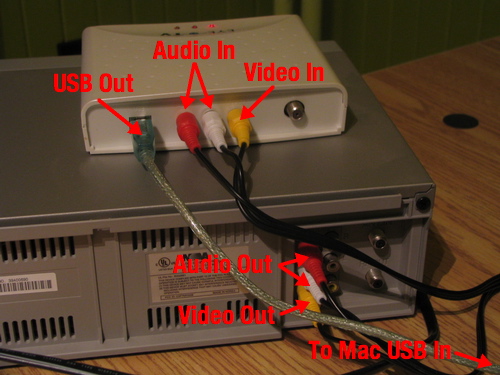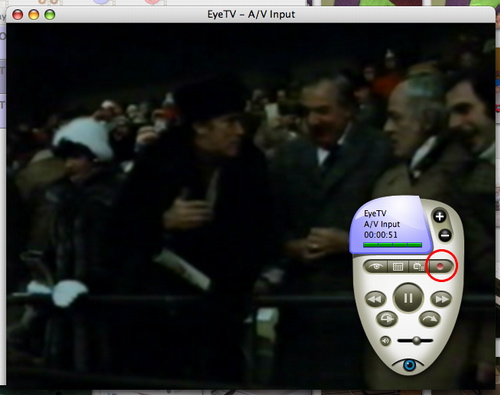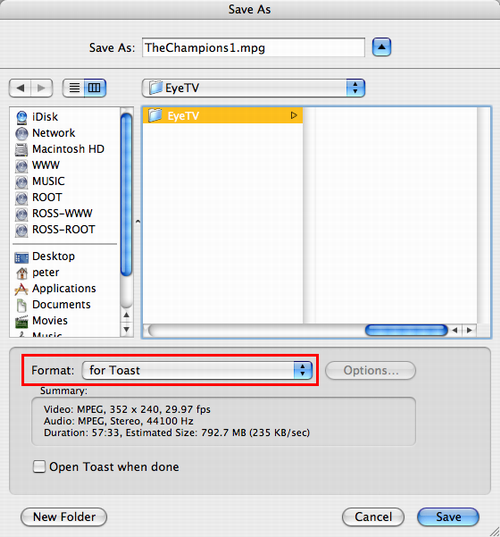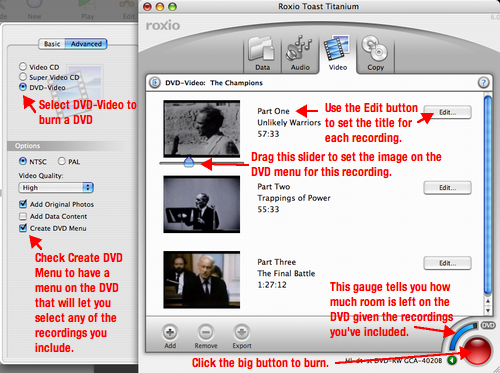Here’s a Yahoo Video Search for Rukavina. An interesting mixture of Minnesota content, CBC stories by Brother Steve, a couple of bold football moves, and a Zap of your PRAM. Thanks to Dave for the pointer to this video search feature: I didn’t know about it until today.
Sometimes you have video on VHS videotapes that you want to make digital, either so you can edit or otherwise manipulate it on a PC, or so you can burn it onto a DVD. I realized yesterday that I had all the pieces to be able to do this myself, so I tried it out, using the NFB series The Champions that I’d borrowed from the Provincial Library. What follows is an explanation of how I did it.
Here’s what I used:
- an iMac equipped with an Apple “SuperDrive” — which is their name for a “DVD burner.”
- an EyeTV box, which is a piece of hardware that converts analog video (from a VCR, antenna, or cable TV) to digital video (i.e. a QuickTime file on my Mac).
- Toast, a commercial software package that makes it easy to drag-and-drop create DVDs (and video CDs — VCDs) from digital video files. Toast is well integrated with the EyeTV software. It may be possible to use open source software for this process; I haven’t tried.
- an off-the-shelf VCR (we bought ours for less than $60 at Futureshop).
- a cable to connect the VCR to the EyeTV.
Here’s what the hardware setup looks like:

The connections on the back look like this:

The one Video Out and the two Audio Out on the VCR get connected to the one Video In and two Audio In on the EyeTV and the EyeTV gets connected to my Mac with a USB cable.
At this point it’s as easy as starting up the EyeTV software (it comes on CD with the hardware, but you can also download the most up-to-date version from the support website), pressing Play on the VCR and clicking on the Record button on the little EyeTV remote control:

EyeTV will digitize everything coming in from the VCR until you hit the Record button again to stop it. Repeat this process for each of the videotapes you want to digitize. When you’re done, you’ll see a list of the recordings in the “EyeTV Programs” window:

I took the extra step of selecting each of the recordings and clicking Info to add a title; you don’t really need to do this.
I also used the built-in EyeTV video editor to trim off the static at the beginning and end of the recordings; if you’re more accurate on the “hit play and record at the same time” action, you might not need to do this. The edit function is relatively easy to figure out:

You can mark sections of the recording by dragging the little triangles, and then click Compact to remove the marked bits. Note that EyeTV isn’t very quick at this: it can take up to five minutes to process this, so it’s more efficient to mark all of the bits you want to remove at the same time, then compact all at once.
Next you need to export each of the recordings in a Toast-compatible format. Fortunately, EyeTV makes this very easy. Select each recording in turn and select File and Export, enter a filename, and make sure you select for Toast as the format:

The result will be a file with an “mpg” extension for each recording (note that if you only have one recording, selecting File and Burn DVD is an even faster way of doing this and the next step together).
Start up Toast, and drag each of the files you exported from EyeTV into the main Toast window. For each recording, you can click the Edit button to set the title (up to three lines; the last line defaults to the length of the recording, but you can change this). You can also set the image to be used on the DVD menu for each recording by dragging a slider that will appear if you click on the thumbnail of the recording:

Select the DVD-Video radio button to burn a DVD, and if you have more than one recording, check the Create DVD Menu box so that Toast will automatically build a menu for the DVD allowing you to select which recording to play.
Pay attention to the “fuel gauge” in the bottom right corner: it’s a live update of the amount of space used and remaining on a DVD given the recordings you’ve included; if it’s not reading “full,” then you’ve still got room — if it is full then you’ll have to remove recordings (highlight and click the Remove icon).
Insert a blank DVD into the SuperDrive, and click the big red “burn” button in the lower right corner to start the DVD creation process, then click Record on the dialog box that pop’s up. Toast will go through a somewhat lengthy process of encoding and then burning the DVD. When it’s done, the DVD will automatically eject, and you’ll have something that will play in almost any DVD player.
Oliver and I spent an hour and a half listening to Cross Country Checkup, the CBC’s national open line show, on our way back from Sackville on Sunday (you can listen to an archive of the show here).
The topic was “Is the same-sex marriage battle over?” in reaction to the Supreme Court of Canada Reference that was released last week.
The program was mostly infuriating, as a cavalcade of “marriage is a sacred procreative union of man and woman and has been for thousands of years” callers squirmed to justify their “uniqueness” without appearing “bigoted.” Here is a typical example of this, from a caller from Saskatoon:
The redefinition of marriage as it’s being proposed really does trump the notion of equality; I think that if this passes it will inflict irreparable damage on this institution and I think that, you know, to give a homosexual couple civil union status with according benefits is fine, we could all accept that, but I do wish these people would not explode the last vestiges of this universally sacred institution. Could they not leave us that. We allow their culture, and ask only that they allow ours.
Thankfully there were more rational callers, like this guy from Nova Scotia:
I just hope I don’t lose too many friends after tonight… I’m just an ordinary hetrosexual person, but to me it is a matter of principle, and it’s a principle of equality, in rights, and in dignity. I find it quite hypocritical to hear people say “give them their rights,” like the last caller said, but what I hear behind is “as long as their rights are not our rights.”
I’ve looked deep, deep within myself to try and find a scintilla of reasoning why men shouldn’t be allowed to marry men and women shouldn’t be allowed to marry women. I come up dry.
Even if, for some odd religious reason, you think gays and lesbians are “evil” I can’t understand why “allowing them” to marry is so threatening to some. And I can’t understand why “they” are “them” and “we” are “us.”
And even if it is threatening, it disturbs me that people can’t look beyond their own discomfort and look at the broader issues of equality involved.
And even if people can’t muster enough strength to think about equality when it runs contrary to their base instincts, I can’t understand how in any way it makes sense to turn away from two people, regardless of gender, who voluntarily say “we love each other, and we’d like to make a public commitment to that love.” In what way can that be construed as a negative or harmful endeavour?
When I was a kid in elementary school, one of the worst insults you could hurl at someone — and we did it all the time — was “you’re so gay.” There was also lots of “suck me off” talk. I’m sure most of us didn’t know what we were talking about (I didn’t learn what “gay” meant until I was ten years old: I watched this episode of The Bob Newhart Show and asked my father; I can’t remember what he told me, but I know it was a more open-minded answer than the fathers of most of my friends would have given).
Through my youth, though, it was pretty clear, both in the popular culture and on the playground, that “being gay” wasn’t something to aspire to. And I didn’t even get the condemnations from the pulpit that kids in religious families would have.
As much as I’d like to think otherwise, I can’t help but thinking that the reaction against same-sex marriage is rooted in deep-seated fear, ignorance and discomfort about homosexuality, gay sex and gay culture. Although it has become de rigueur to pay a constricted sort of respect to gays and lesbians — this is what “give them their rights” means, I think — if you scratch beneath the surface, I think there’s a huge popular well of anti-gay sentiment in Canada.
If all of the “God’s sacred relationship between man and woman” rhetoric is simply cover for “we’re queasy about gay sex” — and I suspect that a large part of it is — what can we do about that? And, perhaps even worse, if large numbers of Canadians are members of anti-gay religious sects, how do others who aren’t live in community with them?
I want to live in a world where people are free to express different opinions, live different lives, eat different foods, practice different faiths, follow different paths; a world where as much as we hold our own personal beliefs dear, we’re smart enough, and guided by a sense of justice strong enough, and courageous enough to know that even when things made us afraid or uncomfortable or seem to involve a lot of change, a higher power of mutual respect and understanding guides us towards following the path of equality, plurality, and understanding.
How do we get there?
Here’s a final round-up of good kid-friendly experiences that Oliver and I indulged in over the weekend.
The Discovery Center on Barrington Street was a lot of fun: we spent almost three hours there. It’s no Ontario Science Centre and it looks like no new money has been invested in a decade, as things are a little dated. But its small size works for it: we didn’t get exhausted or overwhelmed by the need to “see everything.” The Van der Graaf show uses a dinky little aparatus and cotton balls, but the host is goofy and endearing and, again, the small scale (there were only 8 of us in the audience) makes for a much better experience — and more opportunities for questions — than in a “big city” science centre. Highlights for us: the Bernoulli exhibit, with compressed air and pingpong balls, kept both of us entertained for at least 15 minutes; the bubble room is great, especially the “wrap yourself inside a giant bubble” exhibit; there’s a great set of Brio-brand construction toys on the third floor that were a sort of cross between Meccano and Lego. Cost: $11.50 for both of us.
The Maritime Museum of the Atlantic was somewhat less kid-centric, with lots of ship models and examples of historical lamps. But the original models from the ill-fated Theodore Tugboat program are there, which was enough to keep Oliver going for half an hour (it is really quite a neat setup) and there are enough old anchors, full-sized sailboats and canoes, and giant lighthouse mirrors to make it a worthwhile visit. Theodore Too, a full-sized replica of Theodore, is moored in the harbour just up the shore near Murphy’s restaurant; in the summer they offer tours of the harbour, but even in the winter it’s a cool stop just to take a look from the wharf. Admission to the Museum was $4.00 for me, and free for Oliver.
Even though I’m quite averse to the “ye olde” waterfront developments that have infected the eastern seaboard, the Historic Properties on the waterfront in Halifax do have a couple of things going for them: there’s a nice food court with a decent selection of vendors at the water-end of the main building, and the Maps & Ducks store — selling maps, travel guides and duck decoys — was interesting (Oliver likes globes and flags) and the staff were nice. We gave the balance of the ye olde merchants a pass.
Right next door is the Dartmouth Ferry where, for $1.75 each way, you can cruise over to Dartmouth and back. We didn’t do it this visit — ran out of time — but we did go over last year, and it was lot’s of fun.
The big Mountain Equipment Coop store downtown was interesting, and they had a surprisingly broad selection of surprisingly inexpensive (at least relative to expectation, if not to Wal-mart) children’s gear.
Otherwise for eating, we ate Friday dinner at “I Love Sushi” on Blowers Street, a longtime favourite of ours. Friendly staff, a nice fish pond, and good food. Saturday night we hiked up to Maki Maki on Spring Garden Road for another sushi meal, this time in a bento box, which Oliver quite enjoyed (we walked, but there’s a bus that goes right out Spring Garden that would be a good option on a really cold day). It turns out that Satisfaction Feast, a vegetarian restaurant, was right next door to our hotel; we didn’t go in this visit, but we plan to try it next time. Finally, there’s a brand new downtown Pete’s Frootique on Dresden Row, off Spring Garden Road, open 7 days a week long hours. We picked up Samosas for the train ride home, along with special Christmas treats for our friend Ann. They also have a very nice juice bar and deli counter.
We stayed two nights at the new Residence Inn by Marriott, which is very central — on Grafton St. between the Public Library and the Metro Centre. We had a “studio suite” for $99/night, which was the special weekend rate. This was a larger room with king bed, pull-out sofa bed, and full kitchen. They have a great selection of videotapes that you can borrow and watch in the lounge downstairs, and the rate includes a full hot breakfast buffet, which was better than most (and included do-it-yourself waffle making station, which Oliver really liked). The place was clean, and the staff were universally nice and helpful. We’ll stay there again.
Catherine and Oliver tried to go and see Boomer Gallant and Bruce Rainnie in their “night of songs and comedy” next door at Trinity United Church tonight, but there wasn’t a seat in the house to be had. As anyone who has watched the Trinity services on cable television on Sunday mornings knows, Trinity is a huge church, so this is quite a feat. Who can pass up the opportunity to see their beloved local news and weather men sing Christmas carols? Obviously not many!
 My IAXy arrived today. This is a little blue and orange box, about the size of a deck of cards, that lets me connect a regular old telephone set to my Asterisk phone system.
My IAXy arrived today. This is a little blue and orange box, about the size of a deck of cards, that lets me connect a regular old telephone set to my Asterisk phone system.
The IAXy has an RJ-45 Ethernet jack and a RJ-11 phone jack: I plug the Ethernet into the network (which gets it to the Asterisk server) and the phone into the phone jack, and I’ve done all my hardware setup.
Software setup is a little more cumbersome than with the Sipura SPA-2000 that we use here for the same purpose (albeit using the SIP rather than the IAX2 protocol): while the Sipura unit has a friendly web-based configuration tool, the IAXy requires compiling a small Unix utility which is then used to provision the IAXy, which has already obtained an IP address via DHCP. This went quickly and easily, though, and wasn’t really a problem. Otherwise, all that was required was some small additions to the Asterisk iax.conf file. The installation guide covers this in just enough detail.
On the networking side, all I needed to do was open up UDP port 4659 in the firewall to allow access via IAX2 to the Asterisk server (I forgot to do this originally, and nothing was working at all).
Twenty minutes after I started, I was in business: picked up the phone and got a dial tone and phoned home and Catherine sounded like she was in the next room.
Next step is to take little IAXy home, where, if all goes according to plan, he will become the gateway to the Asterisk system from there.
Steven points out that the CBC has reworked their new RSS feeds page and removed all of the annoying “you must sign over your firstborn child” legalese. Heck, they’ve even got an OPML file listing all their feeds.
Saturday night: Oliver, drifting off to sleep and doing his usual sleep-singing and sleep-talking routine while doing so, is clearly heard to be repeating, mantra-like, “news, weather, Boomer.” He is obviously channelling Bruce Rainnie.
Sunday night: Oliver and I run into Matthew, Stephanie, Mollie and Sam Rainnie outside of Cedar’s where we’d just picked up a Boca Burger to go.
Monday morning: I wake up to CBC Island Morning with Bruce Rainnie singing an Australian Christmas carol about kangaroos.
Monday night: I walk out of Indigo in Charlottetown just as Matthew Rainnie is walking in.
They’re everywhere.
PS: the last time I mentioned Matthew Rainnie in this space, the post was reprinted in the National Post. I should be more careful.
From Steven comes a link to this article in This Magazine, the most salient (and accurate) quote from which is:
The problem is that all of these comparative preferences generate competitive consumption. “Keeping up with the Joneses,” in today’s world, does not always mean buying a tract home in the suburbs. It means buying a loft downtown, eating at the right restaurants, listening to obscure bands, having a pile of Mountain Equipment Co-op gear and vacationing in Thailand. It doesn’t matter how much people spend on these things, what matters is the competitive structure of the consumption. Once too many people get on the bandwagon, it forces the early adopters to get off, in order to preserve their distinction. This is what generates the cycles of obsolescence and waste that we condemn as “consumerism.”
MEC. Check (bought a hat for Oliver there on Friday night). Thailand. Check (February 2002). Right restaurants. Not sure (what’s right? do we have “right” restaurants in Charlottetown?). Obscure bands. Check. Loft downtown. Not really, but pretty close. In general, however, they’ve got me pegged.
Three vignettes from the life of Oliver.
On Saturday night in Halifax we walked up a foggy and misty Spring Garden Road to find Maki Maki, a Japanese restaurant near the Dalhousie campus; I suspect we kept walking only because we both enjoyed saying “Maki Maki” so much. Halfway through our excellent meal (a bento box of soup, sushi, salad, tofu and rice) I said to Oliver “would you like some of the seaweed part of my soup.” He responded with an enthusiastic “Yes!” thus placing himself in the small class of preschool seaweed-loving WASP children in Atlantic Canada.
Next, today at Oliver’s pre-school Christmas play, his group led off the festivities with a sing-song of three carols. Oliver not only refused to do any of the song actions nor sing any of the words, but he kept trying to hold the hand of the little girl beside him. Rock on you iconoclast you.
Finally, Oliver, completely of his own invention, has decided to call Chistmas trees “crispin’ trees” this year.
 I am
I am